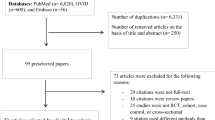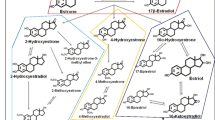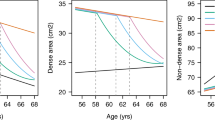Abstract
Mammographically detected breast density has been correlated with breast cancer risk. Breast density appears to be influenced by hormonal factors including increasing age, postmenopausal status, number of pregnancies, lower body weight, hormone replacement therapy, and tamoxifen therapy. The aromatase inhibitor letrozole profoundly reduces breast and circulating estrogen levels in postmenopausal women. We hypothesize that letrozole may reduce breast density and report here on its effects on mammographic breast density, bone mineral density (BMD), bone biomarkers, plasma hormone, and serum lipid levels. MAP1 was a multicenter, randomized, double-blind, placebo-controlled, feasibility trial in which postmenopausal women with or without prior invasive breast cancer were randomized in a 2:1 ratio of letrozole (2.5 mg daily) or placebo for 12 months and followed for a total of 24 months. Eligible women had an estimated >25% breast density on baseline mammogram. The primary endpoint was change in percent breast density (PD) between the baseline and 12-month mammograms as estimated by a computer-assisted thresholding program. Baseline and 12-month mammographic density was also assessed in a blinded manner by visual inspection. Secondary endpoints included changes in serum hormones, plasma lipid levels, bone biomarkers, and BMD. Data are available for 67 women (44 on letrozole and 23 on placebo). No significant changes in PD were noted between the treatment arms at either 12 or 24 months. No distinguishable difference in density measurements by visual inspection were noted between baseline and 12-month mammograms. A significant decrease in percentage change in T-score of the femoral neck at 12 months was noted in the letrozole arm without other significant changes in BMD parameters. Lipid values did not differ between treatment groups except for a borderline significant decrease in total cholesterol at 3 months among women treated with letrozole. Letrozole therapy was associated with a significant reduction in mean serum estradiol, estrone, and estrone sulfate levels at 12 months, but not at 24 months. A significant increase in serum IGF-1 levels was also noted in the letrozole group compared to the placebo group at both 12 and 24 months. To conclude, compared with placebo, 12 months of letrozole therapy does not appear to have a significant effect on mammographic PD. Twelve months of letrozole was associated with a decrease of uncertain clinical significance in the T-score of the femoral neck at 12 months which was reversible at 24 months with recovery of estrogen levels. Letrozole therapy was found to increase IGF-1 levels at 12 and 24 months.
Similar content being viewed by others
References
Boyd NF, Byng JW, Jong RA et al (1995) Quantitative classification of mammographic densities and breast cancer risk: results from the Canadian National Breast Screening Study. J Natl Cancer Inst 87:670–675
Boyd NF, Guo H, Martin LJ et al (2007) Mammographic density and the risk and detection of breast cancer. N Engl J Med 356:227–236
Boyd NF, Rommens JM, Vogt K et al (2005) Mammographic breast density as an intermediate phenotype for breast cancer. Lancet Oncol 6:798–808
Byrne C, Schairer C, Brinton LA et al (2001) Effects of mammographic density and benign breast disease on breast cancer risk (United States). Cancer Causes Control 12:103–110
Byrne C, Schairer C, Wolfe J et al (1995) Mammographic features and breast cancer risk: effects with time, age, and menopause status. J Natl Cancer Inst 87:1622–1629
Harvey JA, Bovbjerg VE (2004) Quantitative assessment of mammographic breast density: relationship with breast cancer risk. Radiology 230:29–41
McCormack VA, dos Santos Silva I (2006) Breast density and parenchymal patterns as markers of breast cancer risk: a meta-analysis. Cancer Epidemiol Biomarkers Prev 15:1159–1169
Ursin G, Ma H, Wu AH et al (2003) Mammographic density and breast cancer in three ethnic groups. Cancer Epidemiol Biomarkers Prev 12:332–338
Wolfe JN, Saftlas AF, Salane M (1987) Mammographic parenchymal patterns and quantitative evaluation of mammographic densities: a case-control study. AJR Am J Roentgenol 148:1087–1092
Greendale GA, Reboussin BA, Sie A et al (1999) Effects of estrogen and estrogen-progestin on mammographic parenchymal density. Postmenopausal Estrogen/Progestin Interventions (PEPI) Investigators. Ann Intern Med 130:262–269
Knight JA, Martin LJ, Greenberg CV et al (1999) Macronutrient intake and change in mammographic density at menopause: results from a randomized trial. Cancer Epidemiol Biomarkers Prev 8:123–128
Cyrlak D, Wong CH (1993) Mammographic changes in postmenopausal women undergoing hormonal replacement therapy. AJR Am J Roentgenol 161:1177–1183
Rutter CM, Mandelson MT, Laya MB, Seger DJ, Taplin S (2001) Changes in breast density associated with initiation, discontinuation, and continuing use of hormone replacement therapy. JAMA 285:171–176
Stomper PC, Van Voorhis BJ, Ravnikar VA, Meyer JE (1990) Mammographic changes associated with postmenopausal hormone replacement therapy: a longitudinal study. Radiology 174:487–490
Atkinson C, Warren R, Bingham SA, Day NE (1999) Mammographic patterns as a predictive biomarker of breast cancer risk: effect of tamoxifen. Cancer Epidemiol Biomarkers Prev 8:863–866
Brisson J, Brisson B, Cote G, Maunsell E, Berube S, Robert J (2000) Tamoxifen and mammographic breast densities. Cancer Epidemiol Biomarkers Prev 9:911–915
Chow CK, Venzon D, Jones EC, Premkumar A, O’Shaughnessy J, Zujewski J (2000) Effect of tamoxifen on mammographic density. Cancer Epidemiol Biomarkers Prev 9:917–921
Cuzick J, Warwick J, Pinney E, Warren RM, Duffy SW (2004) Tamoxifen and breast density in women at increased risk of breast cancer. J Natl Cancer Inst 96:621–628
Konez O, Goyal M, Reaven RE (2001) Can tamoxifen cause a significant mammographic density change in breast parenchyma? Clin Imaging 25:303–308
Son HJ, Oh KK (1999) Significance of follow-up mammography in estimating the effect of tamoxifen in breast cancer patients who have undergone surgery. AJR Am J Roentgenol 173:905–909
Ursin G, Pike MC, Spicer DV, Porrath SA, Reitherman RW (1996) Can mammographic densities predict effects of tamoxifen on the breast? J Natl Cancer Inst 88:128–129
Dowsett M, Jones A, Johnston SR, Jacobs S, Trunet P, Smith IE (1995) In vivo measurement of aromatase inhibition by letrozole (CGS 20267) in postmenopausal patients with breast cancer. Clin Cancer Res 1:1511–1515
Geisler J (2003) Breast cancer tissue estrogens and their manipulation with aromatase inhibitors and inactivators. J Steroid Biochem Mol Biol 86:245–253
Miller WR, Dixon JM (2001) Local endocrine effects of aromatase inhibitors within the breast. J Steroid Biochem Mol Biol 79:93–102
Jong R, Fishell E, Little L, Lockwood G, Boyd NF (1996) Mammographic signs of potential relevance to breast cancer risk: the agreement of radiologists’ classification. Eur J Cancer Prev 5:281–286
Byng JW, Boyd NF, Fishell E, Jong RA, Yaffe MJ (1994) The quantitative analysis of mammographic densities. Phys Med Biol 39:1629–1638
Boyd NF, Greenberg C, Lockwood G et al (1997) Effects at two years of a low-fat, high-carbohydrate diet on radiologic features of the breast: results from a randomized trial. Canadian Diet and Breast Cancer Prevention Study Group. J Natl Cancer Inst 89:488–496
Stone J, Gunasekara A, Martin LJ, Yaffe M, Minkin S, Boyd NF (2003) The detection of change in mammographic density. Cancer Epidemiol Biomarkers Prev 12:625–630
Vachon CM, Ingle JN, Suman VJ et al (2007) Pilot study of the impact of letrozole vs. placebo on breast density in women completing 5 years of tamoxifen. Breast 16:204–210
Noh JJ, Maskarinec G, Pagano I, Cheung LW, Stanczyk FZ (2006) Mammographic densities and circulating hormones: a cross-sectional study in premenopausal women. Breast 15:20–28
Aiello EJ, Tworoger SS, Yasui Y et al (2005) Associations among circulating sex hormones, insulin-like growth factor, lipids, and mammographic density in postmenopausal women. Cancer Epidemiol Biomarkers Prev 14:1411–1417
Warren R, Skinner J, Sala E et al (2006) Associations among mammographic density, circulating sex hormones, and polymorphisms in sex hormone metabolism genes in postmenopausal women. Cancer Epidemiol Biomarkers Prev 15:1502–1508
Verheus M, Peeters PH, van Noord PA, van der Schouw YT, Grobbee DE, van Gils CH (2007) No relationship between circulating levels of sex steroids and mammographic breast density: the Prospect-EPIC cohort. Breast Cancer Res 9:R53
Bremnes Y, Ursin G, Bjurstam N, Rinaldi S, Kaaks R, Gram IT (2007) Endogenous sex hormones, prolactin and mammographic density in postmenopausal Norwegian women. Int J Cancer 121:2506–2511
Boyd NF, Stone J, Martin LJ et al (2002) The association of breast mitogens with mammographic densities. Br J Cancer 87:876–882
Greendale GA, Palla SL, Ursin G et al (2005) The association of endogenous sex steroids and sex steroid binding proteins with mammographic density: results from the Postmenopausal Estrogen/Progestin Interventions Mammographic Density Study. Am J Epidemiol 162:826–834
Tamimi RM, Hankinson SE, Colditz GA, Byrne C (2005) Endogenous sex hormone levels and mammographic density among postmenopausal women. Cancer Epidemiol Biomarkers Prev 14:2641–2647
Greendale GA, Huang MH, Ursin G et al (2007) Serum prolactin levels are positively associated with mammographic density in postmenopausal women. Breast Cancer Res Treat 105:337–346
Byrne C, Colditz GA, Willett WC, Speizer FE, Pollak M, Hankinson SE (2000) Plasma insulin-like growth factor (IGF) I, IGF-binding protein 3, and mammographic density. Cancer Res 60:3744–3748
Diorio C, Pollak M, Byrne C et al (2005) Insulin-like growth factor-I, IGF-binding protein-3, and mammographic breast density. Cancer Epidemiol Biomarkers Prev 14:1065–1073
Maskarinec G, Williams AE, Kaaks R (2003) A cross-sectional investigation of breast density and insulin-like growth factor I. Int J Cancer 107:991–996
Bremnes Y, Ursin G, Bjurstam N, Rinaldi S, Kaaks R, Gram IT (2007) Insulin-like growth factor and mammographic density in postmenopausal Norwegian women. Cancer Epidemiol Biomarkers Prev 16:57–62
Boyd NF, Connelly P, Byng J et al (1995) Plasma lipids, lipoproteins, and mammographic densities. Cancer Epidemiol Biomarkers Prev 4:727–733
Hong CC, Tang BK, Hammond GL, Tritchler D, Yaffe M, Boyd NF (2004) Cytochrome P450 1A2 (CYP1A2) activity and risk factors for breast cancer: a cross-sectional study. Breast Cancer Res 6:R352–R365
Perez EA, Josse RG, Pritchard KI et al (2006) Effect of letrozole versus placebo on bone mineral density in women with primary breast cancer completing 5 or more years of adjuvant tamoxifen: a companion study to NCIC CTG MA.17. J Clin Oncol 24:3629–3635
Lonning PE, Geisler J, Krag LE et al (2005) Effects of exemestane administered for 2 years versus placebo on bone mineral density, bone biomarkers, and plasma lipids in patients with surgically resected early breast cancer. J Clin Oncol 23:5126–5137
Wasan KM, Goss PE, Pritchard PH et al (2005) The influence of letrozole on serum lipid concentrations in postmenopausal women with primary breast cancer who have completed 5 years of adjuvant tamoxifen (NCIC CTG MA.17L). Ann Oncol 16:707–715
Author information
Authors and Affiliations
Corresponding author
Rights and permissions
About this article
Cite this article
Cigler, T., Tu, D., Yaffe, M.J. et al. A randomized, placebo-controlled trial (NCIC CTG MAP1) examining the effects of letrozole on mammographic breast density and other end organs in postmenopausal women. Breast Cancer Res Treat 120, 427–435 (2010). https://doi.org/10.1007/s10549-009-0662-0
Received:
Accepted:
Published:
Issue Date:
DOI: https://doi.org/10.1007/s10549-009-0662-0




